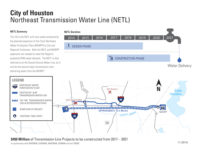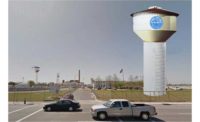Amid rigorous scheduling demands, construction is wrapping up on an $18 million project to build a 20-mile, high-capacity pipeline in Pecos to deliver water for use in hydraulic fracturing projects.
The water infrastructure system will deliver more than 100,000 barrels of water per day to energy producers in the Delaware Basin, one of the most active oil fields in the U.S.
Layne Christensen Co., a large water well drilling company based in The Woodlands, Texas, is the project owner. The system is anchored by nearly 1,000 acres of company-owned, highly productive, water-producing land near Pecos. Infrastructure will include non-potable water wells, pump stations and in-ground storage reservoirs.
Houston engineering firm Lockwood, Andrews & Newnam (LAN) designed and managed construction for the pipeline and infrastructure system. In completing the project by the end of July, contractors will have met the demands of an ultra-tight schedule, which included a roughly 90-day window to construct the pipeline. All told, contractors installed nearly 107,000 linear ft of 22-in DR-17 pipe.
“Probably very few pipelines have been installed with the amount of linear footage and the size of pipe we had, and in the time frame in which it was constructed,” says LAN project engineer Alex Kajdan.
Layne needed to install the line to start selling water as soon as possible to meet the demands of its oil and gas customers and start selling water right away. “Schedule is definitely one of the biggest constraints on this project,” says Byron Bevers, business development engineer for Layne Christensen.
The project began in November with a feasibility study that LAN performed, as well as a hydraulic analysis of Layne’s systems. This analysis evaluated different pipe materials, sizes and pressure classes to help determine the most economical pipe sizes for delivering 100,000 barrels of water per day. Ultimately a 22-in high-density polyethylene (HDPE) pipe was chosen for its reliability, durability and ability to withstand harsh conditions.
“It made sense from a financial standpoint and also to meet the needs of the system,” Kajdan says.
To ensure a tight turnaround for construction, Layne ordered the project materials in February to allow the manufacturer enough time to produce the 20 miles of pipe. Layne then split the project into multiple phases to allow multiple contractors to work on the project simultaneously, with procurement done through a design-bid-build process.
For the construction of the pipeline and pump station, Layne had the option of awarding three different contracts, but ended up awarding all three to a single contractor, C&C Oil Field Construction out of New London, Texas.
“They were able to staff up appropriately to meet our timeline demands,” Bevers says.
One tool that sped up the project significantly was a fast-fusion machine that C&C used to fuse the HDPE pipe together. “They were actually installing pipe at a rate of 3,000 ft per day at their high point, which is really significant. They were working 24 hours a day,” Bevers says.
Use of the tool is noteworthy because there are only a handful of fast fusers in the country that are capable of fusing pipe of that size, Kajdan says. “We were very fortunate to use that on this project,” he says. “The production rates on these fast fusers are pretty significant. You can double your production rate with a fast fuser, versus a standard fuser machine.”
Charger Services LLC of Midland, Texas, was awarded the contract to construct a storage reservoir to accommodate 750,000 barrels. Because this involved a large amount of dirt work and mass excavation, Charger Services was able to employ its sizeable fleet of scrapers and mass excavation equipment and relied on an innovative technique for forming the pit’s surfaces. Charger was able to take the engineers’ computer-drawn images of the pit’s surfaces and plug that data into the GPS unit on its surface equipment. This way, Charger was able to fine-tune the pit’s shape to meet specifications. “So it truly was an engineered pit from the ground up,” Kajdan says.
One of the primary focuses of the pit was making sure that it would be possible to bury much of the piping, hose and valves that would normally be an above-grade obstruction. LAN came up with an innovative design to install a concrete sump at the bottom of the pit and bury the line under the berm.
With most of the project now complete, Layne is already using its pump station to deliver water off the pipeline. And through an automated system that LAN developed, Layne will have remote access to the site to monitor pit levels, as well as how flow and pressure at the pump station and along each point in the line where customers are taking water.
“All of this can be done either from Layne’s Midland office, or remotely from its Woodlands office. So it’s a pretty unique setup,” Kajdan says.








